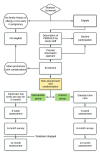PEBBLES study protocol: a randomised controlled trial to prevent atopic dermatitis, food allergy and sensitisation in infants with a family history of allergic disease using a skin barrier improvement strategy
- PMID: 30867201
- PMCID: PMC6430027
- DOI: 10.1136/bmjopen-2018-024594
PEBBLES study protocol: a randomised controlled trial to prevent atopic dermatitis, food allergy and sensitisation in infants with a family history of allergic disease using a skin barrier improvement strategy
Abstract
Introduction: The skin is an important barrier against environmental allergens, but infants have relatively impaired skin barrier function. There is evidence that impaired skin barrier function increases the risk of allergic sensitisation, atopic dermatitis (AD) and food allergy. We hypothesise that regular prophylactic use of emollients, particularly those that are designed to improve skin barrier structure and function, will help prevent these conditions. With the aim of determining if application of a ceramide-dominant emollient two times per day reduces the risk of AD and food allergy, we have commenced a multicentre phase III, outcome assessor blinded, randomised controlled trial of this emollient applied from birth to 6 months.
Methods and analysis: Infants (n=760) with a family history of allergic disease will be recruited from maternity hospitals in Melbourne. The primary outcomes are as follows: the presence of AD, assessed using the UK Working Party criteria, and food allergy using food challenge, in the first 12 months of life as assessed by a blinded study outcome assessor. Secondary outcomes are as follows: food sensitisation (skin prick test), skin barrier function, AD severity, the presence of new onset AD after treatment cessation (between 6 and 12 months) and the presence of parent reported AD/eczema. Recruitment commenced in March 2018.
Ethics and dissemination: The PEBBLES Study is approved by the Human Research Ethics Committees of the Royal Children's Hospital (RCH) (#37090A) and the Mercy Hospital for Women (2018-008). Parents or guardians will provide written informed consent. Outcomes will be disseminated through peer-reviewed publications and presented at scientific conferences.
Trial registration numbers: ACTRN12617001380381 and NCT03667651.
Keywords: allergy; asthma; eczema; paediatric dermatology.
© Author(s) (or their employer(s)) 2019. Re-use permitted under CC BY-NC. No commercial re-use. See rights and permissions. Published by BMJ.
Conflict of interest statement
Competing interests: MT is a member of the Medical Advisory Board (Oceania) for Nestle Nutrition Institute, a member of the Medical Advisory Board (Australia New Zealand) for Danone Nutricia and a member of the Scientific Advisory Board for Immunology Allergy (Global) for Danone Nutricia; and has received lecture fees from Danone and Nestle Nutrition Institute; and has received travel fees from APAPARI. KJA has received speaker’s honoraria from Abbott, Danone, Nestle and Alphapharm. MA has received investigator-initiated grants from Pfizer and Boehringer-Ingelheim for unrelated research. He has also received from Sanofi assistance with conference attendance and an honorarium for an unrelated consultancy.
References
Publication types
MeSH terms
Substances
Associated data
LinkOut - more resources
Full Text Sources
Medical

